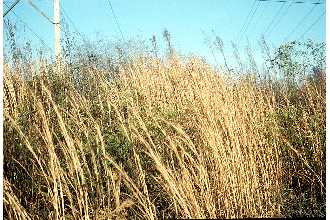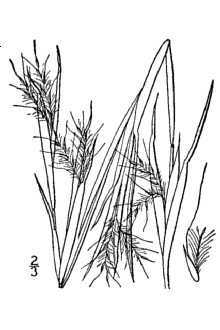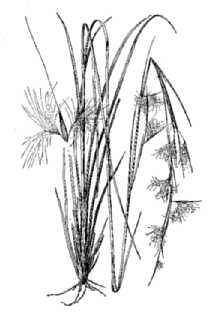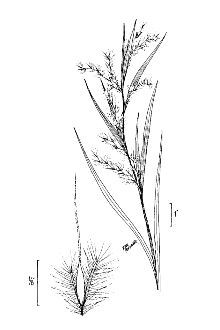Broomsedge Bluestem
Scientific Name: Andropogon virginicus L.
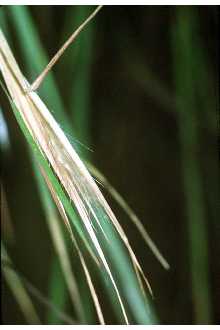
| General Information | |
|---|---|
| Usda Symbol | ANVI2 |
| Group | Monocot |
| Life Cycle | Perennial |
| Growth Habits | Graminoid |
| Native Locations | ANVI2 |
Plant Guide
Alternative Names
Broomsedge, popotillo, whiskey grass, and yellow bluestem. Some botanists consider Andropogon glomeratus and Andropogon virginicus as one species. However, the two grasses are distinct and consistent in appearance and are currently recognized as separate species.
Uses
Livestock: Broomsedge bluestem is grazed readily by cattle in the spring and early summer shortly after growth starts. The nutrition value is low except in early stages of growth. It is unpalatable when mature. Ornamental Landscaping: Broomsedge bluestem is used as an ornament in landscapes. The infloresence is orange in the fall and remains throughout the winter. It provides color to the landscape. Wildlife: Broomsedge bluestem benefits wildlife. Several species of birds and mammals eat the seeds in the winter when the seeds of other plants are not available. Several animals use the plants for cover and nesting sites (especially quail). Grass Images @ Texas A&M University Erosion Control: Broomsedge bluestem is found on low fertile soils and prevents erosion when other plants can not be found. Conservation Practices: Broomsedge bluestem, because of its growth habit, potentially has application when established with certain conservation practices; however, conservation practice standards vary by state. For localized information, consult your local NRCS Field Office.
Status
Consult the PLANTS Web site and your State Department of Natural Resources for this plant’s current status, such as, state noxious status and wetland indicator values.
Description
General: Grass Family (Poaceae). It is a native, warm-season, herbaceous, perennial bunch grass that begins its growth when the average daytime temperature is between 60° to 65° F. The slender, erect culms are up to 4 feet tall. The flattened sheaths are overlapping and with a few scattered hairs. The upper part of the plant is rounded and the lower part is slightly flattened and keeled. The blade is ⅛ to ¼ inch wide, 10 to 16 inches long and rough to the touch above. The ligule is small and membranous. The inflorescence has a panicle of two to four racemes about 1 inch long. The bases of the panicle branches are enclosed in an inflated, tawny spathe as long or longer than the spikelet. The upper lemma of the sessile spikelet has a straight awn that is ½ inch long. The pedicillate spikelet is absent. The seeds mature in 6 weeks to 2 months.
Distribution
Broomsedge bluestem is found on the edges of forests and disturbed areas throughout the eastern United States, For current distribution, consult the Plant Profile page for this species on the PLANTS Web site, Use soil moisture sensors to measure the soil moisture of Broomsedge Bluestem.,
Establishment
Adaptation: Broomsedge bluestem is found in all of Louisiana’s Major Land Resource Areas (MLRA) except for the Gulf Coast Marsh (151). The USDA Hardiness Zones for broomsedge bluestem is 5 to 10. It grows on a wide variety of soils, especially in old fields and other disturbed sites. It is frequently found with Andropogon glomeratus but in higher, better-drained sites. However, broomsedge bluestem might have some allelopathic properties and may cause some other plants to not grow. Broomsedge bluestem is propagated from seeds or by plant division. However, of the two propagation methods, it is best to plant broomsedge bluestem by seeds. The seeds are produced 6 to 8 weeks from when the culms were produced. The seeds should be planted in late winter as a dormant seeding or when daily temperatures average in the low 60’s. The seed can be broadcast and culti-packed if the right field conditions exist. The seeding rate should be 10 to 12 pure live seed pounds/acre. The seeds should be planted to a depth of ¼ to ¾ inch. If the right field conditions do not exist or intensive seedbed preparation is undesirable, then disk the site and leave the surface as rough as possible. Do not attempt to create a smooth uniform appearance for the seedbed. Broadcast the seed and leave it undisturbed. When seeding under minimal seedbed preparation, increase the seeding rate by 50%. It is not recommended to mix broomsedge bluestem seeds with cool season grass seeds. In parts of the United States where cool season grasses dominate, the warm season grasses can be taken over because they develop slower than the cool season grasses. It is also recommended that seed should not be moved more than 300 miles north, 100 miles east or west, or 200 miles south of its point of origin.
Management
Broomsedge bluestem does not require fertilizers as the plants can grow in low fertility areas. Overgrazing and frequent haying of broomsedge bluestem results in an increase of this plant. However, if broomsedge bluestem becomes weedy, then burning, plowing, or mowing is recommended. Check with the local extension service for recommended herbicides. Broomsedge bluestem has no known pests or problems. Cultivars, Improved and Selected Materials (and area of origin) Common seed is readily available from a number of growers, wholesalers, and retailers of native plants.
References
Hitchcock, A.S. 1950. Manual of the grasses of the United States. USDA Miscellaneous Publication No 200. Agricultural Research Administration, Washington, D.C. Pp. 763-765. Texas A&M University 1997. Grass images: Andropogon virginicus. <http://www.csdl.tamu.edu/FLORA/taesgrass/43753000t.jpg>. Bioinformatics Working Group, College Station, Texas. USDA, NRCS 2000. The PLANTS database. <http://plants.usda.gov>. 001106. National Plant Data Center, Baton Rouge, Louisiana.
Fact Sheet
Alternate Names
broomsedge, yellowsedge bluestem, Virginia bluestem, whiskey grass , Use soil moisture sensors to measure the soil moisture of Broomsedge Bluestem.
Uses
Livestock: Broomsedge bluestem is not considered important cattle forage. It provides grazing in spring and early summer. However, nutritional quality and palatability quickly decrease as the summer progresses. Wildlife: Small birds utilize the seed in winter when other food supplies are limited. Broomsedge bluestem provides cover for ground nesting birds such as quail and turkeys. It is a larval host for the Zabulon Skipper butterfly (Poanes zabulon). Ornamental: Broomsedge bluestem is used as an ornamental plant. It is recommended for golf courses and residential landscaping because it requires low amounts of water. In the fall, the foliage turns a reddish orange and retains this color during winter dormancy, thereby adding color to the winter landscape.
Status
Please consult the PLANTS Web site (http://plants.usda.gov ) and your State Department of Natural Resources for this plant’s current status (e.g. threatened or endangered species, state noxious status, and wetland indicator values).
Description and Adaptation
Adaptation
Adaptation
Broomsedge bluestem is a native warm season perennial bunchgrass that grows 2 to 4 feet tall. The leaves are flat to partly folded 10 to 15 inches long and approximately 1/8 inch wide. The fringed ligule is 1/16 inch long. The flattened basal leaf sheaths are colorless or yellow. The rest of the plant is a pale greenish yellow. Broomsedge bluestem produces many seeds on the upper half of the plant that are distributed by the wind. At a distance the inflorescence may appear silvery in the sunlight. Broomsedge bluestem grows where average rainfall is greater than 25 inches. It is found throughout the eastern portion of the United States. The grass is found in open areas such as abandoned fields, overgrazed pastures, cut-over timber sites, and rights of way. Broomsedge grows on a wide variety of soils, preferring loose, sandy, moist sites with low fertility and is an indicator of low phosphorus soils. It also is a shallow rooted plant. Distribution: Please consult the Plant Profile page for this species on the PLANTS Web site.
Establishment
Broomsedge bluestem can be established by direct seeding or transplanting. Direct seeding is the preferred method of establishing a broomsedge bluestem stand. Prepare a firm, weed free seedbed by discing and cultipacking. The site may be prepared by treating the planting area in the spring with a nonselective herbicide such as glyphosate to kill existing vegetation then using a no-till type drill to plant. The best time to plant broomsedge bluestem seeds is in the spring when soil temperature is at least 55°F or greater. The seed should be planted no more than ¼ inch
Management
Native grasses grow slowly and require two to three years to fully establish. Mowing is an effective method for controlling weeds. Mow above the tops of the broomsedge bluestem to reduce weed competition. Mowing only the tops keeps from covering up the small grass seedlings. Weeds can also be controlled by selective herbicides. Imazapic herbicides will control broadleaf weeds and is labeled for use on most warm season grasses. Apply imazapic herbicides in the spring using a boom sprayer after the broadleaf weeds have begun growing. In certain situations, broomsedge bluestem is considered a pasture weed. It increases in plant numbers as more desirable vegetation is selectively grazed by livestock. If left uncontrolled, broomsedge bluestem can become the dominant grass in abused, overgrazed range and pastures. Avoid overgrazing of desirable grasses by managing the number of animals, the duration of their grazing, and amount of herbage that is removed from the pasture. Do not rely on calendar days to determine the number of days for animals to graze a pasture, instead schedule grazing based on plant growth of key species and available forage. If warm season grasses are the desirable species, remove grazing animals when the grasses have 6 to 8 inches of stubble height remaining. Contact your local USDA-NRCS field office for assistance in planning a prescribed grazing plan. Vegetative growth of broomsedge bluestem begins in early spring. To reduce the amount of broomsedge bluestem in a pasture, heavily graze it in early spring when the grass is most palatable and then defer grazing for 60 to 90 days. Increase the soil fertility by adding nitrogen, phosphorus, and potassium based upon soil tests and fertilizer recommendations. Fertilizing the desirable species will help them compete successfully with the broomsedge.
Pests and Potential Problems
On infertile soils, broomsedge is a long-lived competitor. Broomsedge bluestem has allelopathic chemicals which adversely affected other plants (Rice, 1972).
Environmental Concerns
Broomsedge bluestem was inadvertently introduced to the Hawaiian Islands in 1932. It is considered noxious there because it invades native Hawaiian plant communities and alters the fire and hydrology regimes (Diggs, et al., 2006).
Control
By itself, prescribed burning has little detrimental effect on broomsedge bluestem and is not an effective means of control. The aboveground biomass is removed; in response, the plant quickly begins new vegetative growth after a burn. However, the new vegetative growth can be treated with herbicides. Glyphosate herbicides are an effective chemicals to use for control of broomsedge bluestem. Glyphosate herbicides are non-selective. Broadcast spraying of a glyphosate herbicide will result in killing both broomsedge bluestem and desirable vegetation. Therefore, broadcast spraying is not recommended for established stands of desirable vegetation. If a complete canopy kill is the objective, apply the herbicide using a boom sprayer. Apply the herbicide when the plants are actively growing. A follow-up application may be needed. Selective application of glyphosate, such as wicking or spot treatment is recommended in established pastures. When using a wick, raise it above the desired vegetation and sweep the top of the broomsedge bluestem. If the treatment site is smaller with isolated broomsedge colonies, a backpack sprayer is a feasible option to apply herbicide. Make herbicide applications when the broomsedge bluestem plants are actively growing. For all chemical control methods, always read and follow label and safety instructions. Consult your extension weed specialist or county agent for recommended herbicides. Control measures appear in this document only to provide specific information. USDA NRCS does not guarantee or warranty the products and control methods named, and other products may be equally effective. Cultivars, Improved, and Selected Materials (and area of origin) Currently, the cultivar ‘Silver Beauty’ is commercially available. Locally harvested material may be available from local seed dealers.
Prepared By
Melinda Brakie, USDA NRCS East Texas Plant Materials Center, Nacogdoches, Texas
Plant Traits
Growth Requirements
| Temperature, Minimum (°F) | -18 |
|---|---|
| Adapted to Coarse Textured Soils | No |
| Adapted to Fine Textured Soils | Yes |
| Adapted to Medium Textured Soils | Yes |
| Anaerobic Tolerance | None |
| CaCO3 Tolerance | High |
| Cold Stratification Required | No |
| Drought Tolerance | High |
| Fertility Requirement | Low |
| Fire Tolerance | High |
| Frost Free Days, Minimum | 135 |
| Hedge Tolerance | None |
| Moisture Use | Medium |
| pH, Maximum | 7.0 |
| pH, Minimum | 4.9 |
| Precipitation, Maximum | 45 |
| Precipitation, Minimum | 30 |
| Root Depth, Minimum (inches) | 14 |
| Salinity Tolerance | Low |
| Shade Tolerance | Intolerant |
Morphology/Physiology
| After Harvest Regrowth Rate | Slow |
|---|---|
| Toxicity | None |
| Shape and Orientation | Erect |
| Nitrogen Fixation | None |
| Resprout Ability | No |
| Active Growth Period | Summer |
| Bloat | None |
| C:N Ratio | High |
| Coppice Potential | No |
| Fall Conspicuous | No |
| Fire Resistant | No |
| Flower Color | Yellow |
| Flower Conspicuous | No |
| Foliage Color | Green |
| Foliage Porosity Summer | Moderate |
| Foliage Texture | Medium |
| Low Growing Grass | No |
| Lifespan | Moderate |
| Leaf Retention | No |
| Known Allelopath | No |
| Height, Mature (feet) | 3.0 |
| Growth Rate | Slow |
| Growth Form | Bunch |
| Fruit/Seed Conspicuous | No |
| Fruit/Seed Color | Brown |
| Foliage Porosity Winter | Porous |
Reproduction
| Vegetative Spread Rate | None |
|---|---|
| Small Grain | No |
| Seedling Vigor | Low |
| Seed Spread Rate | Slow |
| Seed per Pound | 800000 |
| Fruit/Seed Persistence | No |
| Propagated by Tubers | No |
| Propagated by Sprigs | No |
| Propagated by Sod | No |
| Propagated by Seed | Yes |
| Propagated by Corm | No |
| Propagated by Container | No |
| Propagated by Bulb | No |
| Propagated by Bare Root | No |
| Fruit/Seed Period End | Summer |
| Fruit/Seed Period Begin | Summer |
| Fruit/Seed Abundance | Low |
| Commercial Availability | Routinely Available |
| Bloom Period | Late Spring |
| Propagated by Cuttings | No |
Suitability/Use
| Veneer Product | No |
|---|---|
| Pulpwood Product | No |
| Protein Potential | Low |
| Post Product | No |
| Palatable Human | No |
| Palatable Graze Animal | Low |
| Palatable Browse Animal | Low |
| Nursery Stock Product | No |
| Naval Store Product | No |
| Lumber Product | No |
| Fodder Product | No |
| Christmas Tree Product | No |
| Berry/Nut/Seed Product | No |

